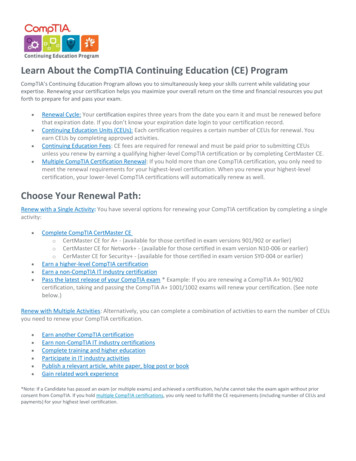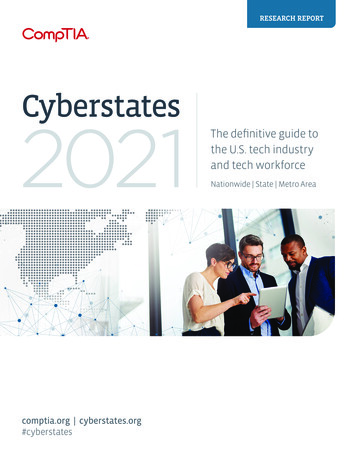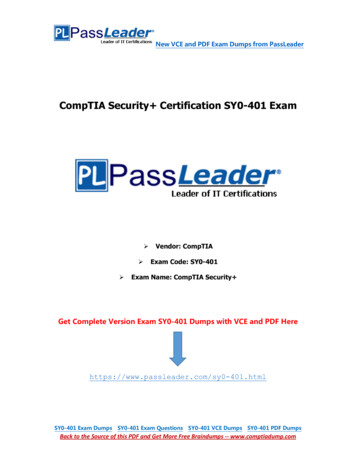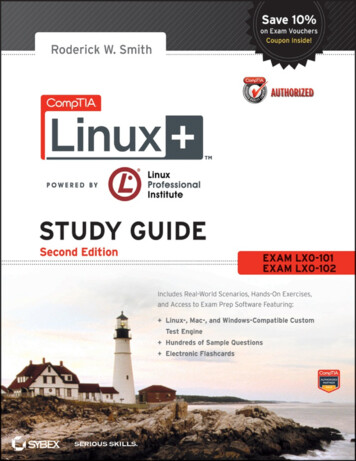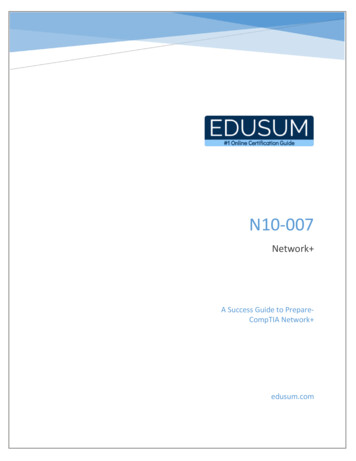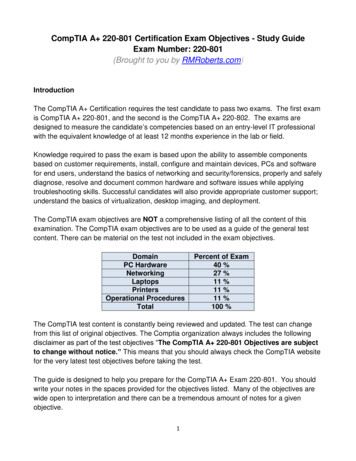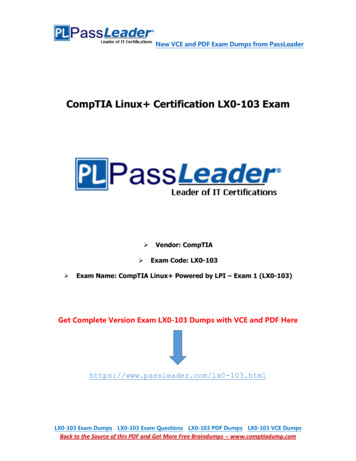
Transcription
Continue
Comptia linux study guide exam xk0-004 pdf downloadGet full access to CompTIA Linux XK0-004 Cert Guide and 60K other titles, with free 10-day trial of O'Reilly. There's also live online events, interactive content, certification prep materials, and more. Learn, prepare, and practice for CompTIA Linux (XK0-004) exam success with this Cert Guide from Pearson IT Certification, a leader in ITCertification learning.Master CompTIA Linux XK0-004 exam topicsAssess your knowledge with chapter-ending quizzesReview key concepts with exam preparation tasksPractice with unique sets of exam-realistic practice questionsCompTIA Linux XK0-004 Cert Guide is a best-of-breed exam study guide. Leading Linux trainers Ross Brunson andWilliam “Bo” Rothwell share preparation hints and test-taking tips, helping you identify areas of weakness and improve both your conceptual knowledge and hands-on skills. Material is presented in a concise manner, focusing on increasing your understanding and retention of exam topics.The book presents you with an organized test-preparationroutine through the use of proven series elements and techniques. Exam topic lists make referencing easy. Chapter-ending Exam Preparation Tasks help you drill on key concepts you must know thoroughly. Review questions help you assess your knowledge, and a final preparation chapter guides you through tools and resources to help you craft yourfinal study plan.CompTIA Linux XK0-004 Cert Guide comes with the powerful Pearson Test Prep practice test software, complete with hundreds of exam-realistic questions. The assessment engine offers you a wealth of customization options and reporting features, laying out a complete assessment of your knowledge to help you focus your studywhere it is needed most. This online assessment engine enables you to access the practice tests via the Internet on any desktop, laptop, tablet, or smartphone device with Internet connectivity. The web-based version also enables you to download the software to your desktop, so you can use the practice test even when you don’t have an Internetconnection. The desktop version syncs with your online version when an Internet connection is established, to update and track your progress. This integrated learning package offers these additional benefits:Enables you to focus on individual topic areas or take complete, timed examsPresents unique sets of exam-realistic practice questionsTracksyour performance and provides feedback on a module-by-module basis, laying out a complete assessment of your knowledge to help you focus your study where it is needed mostWell regarded for its level of detail, assessment features, and challenging review questions and exercises, this study guide helps you master the concepts and techniques thatwill enable you to succeed on the exam the first time.This study guide helps you master all topics on the latest CompTIA Linux exam, includingHardware and system configurationSystems operation and maintenanceSecurityLinux troubleshooting and diagnosticsAutomation and scriptingIt fully reflects major changes to this version of the Linux exam, including new coverage of virtualization, cloud concepts, Git, and orchestration. Table of contents : Content: Introduction xxix Assessment Test xlii Part I Gathering Your Tools 1 Chapter 1 Preparing Your Environment 3 Setting Up a Learning Space 4 Exploring Linux Distributions 8 Locating a Terminal 14 Summary 14 Chapter 2 SiftingThrough Services 15 What is a Linux Server? 16 Serving the Basics 19 Serving Local Networks 24 Implementing Security 29 Improving Performance 32 Summary 33 Exam Essentials 34 Review Questions 35 Chapter 3 Managing Files, Directories, and Text 39 Handling Files and Directories 40 Linking Files and Directories 55 Reading Files 59 FindingInformation 66 Summary 77 Exam Essentials 77 Review Questions 78 Chapter 4 Searching and Analyzing Text 83 Processing Text Files 84 Redirecting Input and Output 95 Editing Text Files 105 Summary 116 Exam Essentials 117 Review Questions 118 Part II Starting Up and Configuring Your System 123 Chapter 5 Explaining the Boot Process 125The Linux Boot Process 126 The Firmware Startup 128 Linux Bootloaders 130 System Recovery 137 Summary 141 Exam Essentials 141 Review Questions 143 Chapter 6 Maintaining System Startup and Services 147 Looking at init 148 Managing systemd Systems 149 Managing SysV init Systems 167 Digging Deeper into systemd 176 Summary 179Exam Essentials 179 Review Questions 181 Chapter 7 Configuring Network Connections 187 Configuring Network Features 188 Basic Network Troubleshooting 201 Advanced Network Troubleshooting 205 Summary 209 Exam Essentials 210 Review Questions 212 Chapter 8 Comparing GUIs 217 Focusing on the GUI 218 Serving Up the GUI 231Using Remote Desktops 235 Forwarding 240 Summary 245 Exam Essentials 245 Review Questions 247 Chapter 9 Adjusting Localization Options 253 Understanding Localization 254 Setting Your Locale 256 Looking at Time 259 Summary 265 Exam Essentials 266 Review Questions 267 Part III Managing Your System 273 Chapter 10 AdministeringUsers and Groups 275 Managing User Accounts 276 Managing Groups 294 Setting Up the Environment 297 Querying Users 300 Managing Disk Space Usage 304 Summary 308 Exam Essentials 308 Review Questions 310 Chapter 11 Handling Storage 315 Storage Basics 316 Partitioning Tools 318 Understanding Filesystems 323 FormattingFilesystems 326 Mounting Filesystems 329 Managing Filesystems 331 Storage Alternatives 333 Summary 338 Exam Essentials 338 Review Questions 340 Chapter 12 Protecting Files 343 Understanding Backup Types 344 Looking at Compression Methods 346 Comparing Archive and Restore Utilities 349 Securing Offsite/Off-System Backups 362Checking Backup Integrity 366 Summary 368 Exam Essentials 368 Review Questions 370 Chapter 13 Governing Software 373 Working with Source Code 374 Packaging Applications 380 Summary 392 Exam Essentials 393 Review Questions 394 Chapter 14 Tending Kernel Modules 397 Exploring Kernel Modules 398 Installing Kernel Modules 402Removing Kernel Modules 404 Summary 405 Exam Essentials 405 Review Questions 407 Part IV Securing Your System 409 Chapter 15 Applying Ownership and Permissions 411 Looking at File and Directory Permissions 412 Access Control Lists 420 Context-Based Permissions 422 Understanding Linux User Types 430 Restricting Users 431Summary 435 Exam Essentials 436 Review Questions 437 Chapter 16 Looking at Access and Authentication Methods 439 Getting to Know PAM 440 Exploring PKI Concepts 452 Using SSH 455 Using VPN as a Client 468 Summary 469 Exam Essentials 469 Review Questions 471 Chapter 17 Implementing Logging Services 473 Understanding theImportance of Logging 474 Basic Logging Using rsyslog 477 Journaling with systemd-journald 480 Summary 483 Exam Essentials 484 Review Questions 485 Chapter 18 Overseeing Linux Firewalls 487 Providing Access Control 488 Looking at Firewall Technologies 490 Forwarding IP Packets 505 Dynamically Setting Rules 506 Summary 508 ExamEssentials 508 Review Questions 510 Chapter 19 Embracing Best Security Practices 513 User Security 514 System Security 518 Network Security 525 Summary 528 Exam Essentials 528 Review Questions 530 Part V Troubleshooting Your System 533 Chapter 20 Analyzing System Properties and Remediation 535 Troubleshooting the Network 536Troubleshooting Storage Issues 549 Troubleshooting the CPU 554 Troubleshooting Memory 556 Surviving a Lost root Password 560 Summary 562 Exam Essentials 562 Review Questions 563 Chapter 21 Optimizing Performance 567 Looking at Processes 568 Monitoring Processes in Real Time 570 Managing Processes 573 Summary 577 ExamEssentials 577 Review Questions 579 Chapter 22 Investigating User Issues 581 Troubleshooting Access 582 Examining File Obstacles 588 Exploring Environment and Shell Issues 591 Summary 593 Exam Essentials 593 Review Questions 594 Chapter 23 Dealing with Linux Devices 597 Communicating with Linux Devices 598 Working with Devices605 Using Hot Pluggable Devices 613 Summary 615 Exam Essentials 616 Review Questions 617 Chapter 24 Troubleshooting Application and Hardware Issues 619 Dealing with Storage Problems 620 Uncovering Application Permission Issues 626 Analyzing Application Dependencies 628 Looking at SELinux Context Violations 633 Exploring FirewallBlockages 633 Troubleshooting Additional Hardware Issues 635 Summary 643 Exam Essentials 643 Review Questions 645 Part VI Automating Your System 649 Chapter 25 Deploying Bash Scripts 651 The Basics of Shell Scripting 652 Advanced Shell Scripting 657 Writing Script Programs 663 Summary 673 Exam Essentials 674 Review Questions 675Chapter 26 Automating Jobs 677 Running Scripts in Background Mode 678 Running Scripts Without a Console 680 Sending Signals 681 Job Control 683 Running Like Clockwork 687 Summary 692 Exam Essentials 693 Review Questions 694 Chapter 27 Controlling Versions with Git 697 Understanding Version Control 698 Setting Up Your GitEnvironment 700 Committing with Git 703 Merging Versions 710 Summary 713 Exam Essentials 713 Review Questions 715 Part VII Realizing Virtual and Cloud Environments 717 Chapter 28 Understanding Cloud and Virtualization Concepts 719 Considering Cloud Services 720 Understanding Virtualization 723 Exploring Containers 727 Exercise 729Summary 730 Exam Essentials 731 Review Questions 732 Chapter 29 Inspecting Cloud and Virtualization Services 735 Focusing on VM Tools 736 Understanding Bootstrapping 740 Exploring Storage Issues 746 Considering Network Configurations 747 Summary 750 Exam Essentials 751 Review Questions 752 Chapter 30 Orchestrating theEnvironment 755 Understanding Orchestration Concepts 756 Provisioning the Data Center 760 Looking at Container Orchestration Engines 763 Summary 765 Exam Essentials 765 Review Questions 766 Appendix Answers to Review Questions 769 Chapter 2: Sifting Through Services 770 Chapter 3: Managing Files, Directories, and Text 773 Chapter4: Searching and Analyzing Text 777 Chapter 5: Explaining the Boot Process 781 Chapter 6: Maintaining System Startup and Services 784 Chapter 7: Configuring Network Connections 788 Chapter 8: Comparing GUIs 791 Chapter 9: Adjusting Localization Options 795 Chapter 10: Administering Users and Groups 798 Chapter 11: Handling Storage801 Chapter 12: Protecting Files 803 Chapter 13: Governing Software 804 Chapter 14: Tending Kernel Modules 806 Chapter 15: Applying Ownership and Permissions 808 Chapter 16: Looking at Access and Authentication Methods 810 Chapter 17: Implementing Logging Services 811 Chapter 18: Overseeing Linux Firewalls 813 Chapter 19:Embracing Best Security Practices 815 Chapter 20: Embracing Best Security Practices 817 Chapter 21: Optimizing Performance 818 Chapter 22: Investigating User Issues 820 Chapter 23: Dealing with Linux Devices 822 Chapter 24: Troubleshooting Application and Hardware Issues 824 Chapter 25: Deploying Bash Scripts 826 Chapter 26:Automating Jobs 827 Chapter 27: Controlling Versions with Git 829 Chapter 28: Understanding Cloud and Virtualization Concepts 831 Chapter 29: Inspecting Cloud and Virtualization Services 832 Chapter 30: Orchestrating the Environment 834 Index 837 Citation preview CompTIA Linux Study Guide Exam XK0-004 Fourth Edition CompTIA Linux Study Guide Exam XK0-004 Fourth Edition Christine Bresnahan Richard Blum Senior Acquisitions Editor: Kenyon Brown Development Editor: Stephanie Barton Technical Editor: David Clinton, Jason Eckert, and Kevin E. Ryan Production Editor: Lauren Freestone Copy Editor: Judy Flynn Editorial Manager: Pete Gaughan Production Manager:Kathleen Wisor Associate Publisher: Jim Minatel Proofreader: Kim Wimpsett Indexer: Johnna VanHoose Dinse Project Coordinator, Cover: Brent Savage Cover Designer: Wiley Cover Image: Getty Images, Inc./Jeremy Woodhouse Copyright 2019 by John Wiley & Sons, Inc., Indianapolis, Indiana Published simultaneously in Canada ISBN: 978-1119-55603-9 ISBN: 978-1-119-55605-3 (ebk.) ISBN: 978-1-119-55604-6 (ebk.) Manufactured in the United States of America No part of this publication may be reproduced, stored in a retrieval system or transmitted in any form or by any means, electronic, mechanical, photocopying, recording, scanning or otherwise, except as permitted underSections 107 or 108 of the 1976 United States Copyright Act, without either the prior written permission of the Publisher, or authorization through payment of the appropriate per-copy fee to the Copyright Clearance Center, 222 Rosewood Drive, Danvers, MA 01923, (978) 750-8400, fax (978) 646-8600. Requests to the Publisher for permission shouldbe addressed to the Permissions Department, John Wiley & Sons, Inc., 111 River Street, Hoboken, NJ 07030, (201) 748-6011, fax (201) 748-6008, or online at . Limit of Liability/Disclaimer of Warranty: The publisher and the author make no representations or warranties with respect to the accuracy or completeness of the contents of this work andspecifically disclaim all warranties, including without limitation warranties of fitness for a particular purpose. No warranty may be created or extended by sales or promotional materials. The advice and strategies contained herein may not be suitable for every situation. This work is sold with the understanding that the publisher is not engaged inrendering legal, accounting, or other professional services. If professional assistance is required, the services of a competent professional person should be sought. Neither the publisher nor the author shall be liable for damages arising herefrom. The fact that an organization or Web site is referred to in this work as a citation and/or a potential sourceof further information does not mean that the author or the publisher endorses the information the organization or Web site may provide or recommendations it may make. Further, readers should be aware that Internet Web sites listed in this work may have changed or disappeared between when this work was written and when it is read. Forgeneral information on our other products and services or to obtain technical support, please contact our Customer Care Department within the U.S. at (877) 762-2974, outside the U.S. at (317) 572-3993 or fax (317) 572-4002. Wiley publishes in a variety of print and electronic formats and by print-on-demand. Some material included with standardprint versions of this book may not be included in e-books or in print-on-demand. If this book refers to media such as a CD or DVD that is not included in the version you purchased, you may download this material at . For more information about Wiley products, visit www.wiley.com. Library of Congress Control Number: 2019940123 TRADEMARKS:Wiley, the Wiley logo, and the Sybex logo are trademarks or registered trademarks of John Wiley & Sons, Inc. and/or its affiliates, in the United States and other countries, and may not be used without written permission. CompTIA is a registered trademark of The Computing Technology Industry Association, Inc. All other trademarks are the propertyof their respective owners. John Wiley & Sons, Inc. is not associated with any product or vendor mentioned in this book. 10 9 8 7 6 5 4 3 2 1 Acknowledgments First, all glory and praise go to God, who through His Son, Jesus Christ, makes all things possible and gives us the gift of eternal life. Many thanks go to the fantastic team of people at Sybex fortheir outstanding work on this project. Thanks to Kenyon Brown, the senior acquisitions editor, for offering us the opportunity to work on this book. Also thanks to Stephanie Barton, the development editor, for keeping things on track and making the book more presentable. Thanks, Steph, for all your hard work and diligence. The technicalproofreaders, Kevin E. Ryan and Jason Eckert, did a wonderful job of double-checking all of the work in the book in addition to making suggestions to improve the content. Also our appreciation goes out to David B. Clinton for taking the reins as technical editor near the close of the project and offering his terrific advice. Thanks also goes to the youngand talented Daniel Anez (theanez.com) for his illustration work. We would also like to thank Carole Jelen at Waterside Productions, Inc., for arranging this opportunity for us and for helping us out in our writing careers. Christine would particularly like to thank her husband, Timothy, for his encouragement, patience, and willingness to listen, evenwhen he has no idea what she is talking about. Christine would also like to express her love for Samantha and Cameron, “May God bless your marriage richly.” Rich would particularly like to thank his wife, Barbara, for enduring his grouchy attitude during this project and helping to keep up his spirits with baked goods. About the Authors ChristineBresnahan, CompTIA Linux , LPIC-1, started working with computers more than 30 years ago in the IT industry as a system administrator. Christine is an adjunct professor at Ivy Tech Community College where she teaches Linux certification and Python programming classes. She also writes books and produces instructional resources for theclassroom. Richard Blum, CompTIA Linux ce, CompTIA Security ce, LPIC-1, has also worked in the IT industry for more than 30 years as both a system and network administrator, and he has published numerous Linux and open-source books. Rich is an online instructor for Linux and web programming courses that are used by colleges anduniversities across the United States. When he is not being a computer nerd, Rich enjoys spending time with his wife, Barbara, and his two daughters, Katie and Jessica. Contents at a Glance Introduction xxix Assessment Test xlii Part I Gathering Your Tools 1 Chapter 1 Preparing Your Environment 3 Chapter 2 Sifting Through Services 15 Chapter 3Managing Files, Directories, and Text 39 Chapter 4 Searching and Analyzing Text 83 Part II Starting Up and Configuring Your System Chapter 5 Explaining the Boot Process 125 Chapter 6 Maintaining System Startup and Services 147 Chapter 7 Configuring Network Connections 187 Chapter 8 Comparing GUIs 217 Chapter 9 Adjusting LocalizationOptions 253 Part Iii Managing Your System 273 Chapter 10 Administering Users and Groups 275 Chapter 11 Handling Storage 315 Chapter 12 Protecting Files 343 Chapter 13 Governing Software 373 Chapter 14 Tending Kernel Modules 397 Part IV Securing Your System Chapter 15 Applying Ownership and Permissions 411 Chapter 16 Looking atAccess and Authentication Methods 439 Chapter 17 Implementing Logging Services 473 Chapter 18 Overseeing Linux Firewalls 487 Chapter 19 Embracing Best Security Practices 513 123 409 xii Contents at a Glance Part V Troubleshooting Your System 533 Chapter 20 Analyzing System Properties and Remediation 535 Chapter 21 OptimizingPerformance 567 Chapter 22 Investigating User Issues 581 Chapter 23 Dealing with Linux Devices 597 Chapter 24 Troubleshooting Application and Hardware Issues 619 Part VI Automating Your System Chapter 25 Deploying Bash Scripts 651 Chapter 26 Automating Jobs 677 Chapter 27 Controlling Versions with Git 697 Part VII Realizing Virtualand Cloud Environments Chapter 28 Understanding Cloud and Virtualization Concepts 719 Chapter 29 Inspecting Cloud and Virtualization Services 735 Chapter 30 Orchestrating the Environment 755 Appendix Answers to Review Questions 769 649 717 Index 837 Contents Introduction xxix Assessment Test Part I Chapter 1 xlii Gathering Your Tools1 Preparing Your Environment 3 Setting Up a Learning Space 4 Using That Old Laptop 4 Creating a Virtualized Environment 5 Jumping to the Cloud 7 Exploring Linux Distributions 8 Looking at CentOS 9 Looking at Ubuntu 10 Looking at openSUSE 12 Looking at Fedora 13 Locating a Terminal 14 Summary 14 Chapter 2 Sifting Through Services 15What Is a Linux Server? 16 Launching Services 17 Listening for Clients 18 Serving the Basics 19 Web Servers 20 Database Servers 21 Mail Servers 22 Serving Local Networks 24 File Servers 25 Print Servers 26 26 Network Resource Servers Implementing Security 29 Authentication Server 29 Certificate Authority 30 Access Server (SSH) 31 VirtualPrivate Networks 31 32 Proxy Server Monitoring 32 xiv Contents Improving Performance 32 Clustering 32 Load Balancing 33 Containers 33 Summary 33 Exam Essentials 34 Review Questions 35 Chapter 3 Managing Files, Directories, and Text 39 40 Handling Files and Directories Viewing and Creating Files 40 Copying and Moving Files 45Removing Files 52 Linking Files and Directories 55 Establishing a Hard Link 55 Constructing a Soft Link 57 59 Reading Files Reading Entire Text Files 59 61 Reading Text File Portions Reading Text File Pages 65 Finding Information 66 Exploring File Differences 67 Using Simple Pinpoint Commands 69 Using Intricate Pinpoint Commands 73Summary 77 Exam Essentials 77 78 Review Questions Chapter 4 Searching and Analyzing Text 83 Processing Text Files Filtering Text Formatting Text Determining Word Count Redirecting Input and Output Handling Standard Output Redirecting Standard Error Regulating Standard Input Piping Commands Creating Here Documents CreatingCommand Lines Editing Text Files Appreciating Text Editors Learning About Stream Editors 84 84 89 93 95 95 96 98 100 102 103 105 105 110 Contents xv Summary 116 Exam Essentials 117 Review Questions 118 Part II Chapter 5 Starting Up and Configuring Your System 123 Explaining the Boot Process 125 126 The Linux Boot ProcessFollowing the Boot Process 126 Viewing the Boot Process 127 128 The Firmware Startup The BIOS Startup 128 The UEFI Startup 129 Linux Bootloaders 130 131 GRUB Legacy GRUB2 134 136 Alternative Bootloaders System Recovery 137 Kernel Failures 137 Root Drive Failure 139 Summary 141 Exam Essentials 141 Review Questions 143 Chapter6 Maintaining System Startup and Services 147 Looking at init 148 Managing systemd Systems 149 Exploring Unit Files 150 Focusing on Service Unit Files 152 Focusing on Target Unit Files 157 Looking at systemctl 159 Examining Special systemd Commands 162 Managing SysV init Systems 167 168 Understanding Runlevels Investigating SysV initCommands 171 Digging Deeper into systemd 176 Looking at systemd Mount Units 176 178 Exploring Automount Units Summary 179 Exam Essentials 179 Review Questions 181 xvi Chapter Contents 7 Configuring Network Connections 187 188 Configuring Network Features Network Configuration Files 188 Graphical Tools 191 193 Command-LineTools Basic Network Troubleshooting 201 Sending Test Packets 201 202 Finding Host Information Advanced Network Troubleshooting 205 The netstat Command 205 Examining Sockets 208 Summary 209 Exam Essentials 210 Review Questions 212 Chapter 8 Comparing GUIs 217 Focusing on the GUI 218 Getting to Know GNOME 219 Probing KDEPlasma 221 Considering Cinnamon 223 Making Acquaintance with MATE 225 Understanding Unity 227 Setting Up Accessibility 228 Serving Up the GUI 231 Figuring Out Wayland 232 Examining X11 234 Using Remote Desktops 235 Viewing VNC 236 Grasping Xrdp 238 Exploring NX 239 Studying SPICE 240 Forwarding 240 Local 242 Remote 243244 Tunneling Your X11 Connection Summary 245 Exam Essentials 245 Review Questions 247 Chapter 9 Adjusting Localization Options Understanding Localization Character Sets Environment Variables 253 254 254 255 Contents xvii Setting Your Locale 256 Installation Locale Decisions 256 Changing Your Locale 257 259 Looking at TimeWorking with Time Zones 259 Setting the Time and Date 260 264 Watching System Time Summary 265 Exam Essentials 266 Review Questions 267 Part Iii Chapter 10 Managing Your System 273 Administering Users and Groups 275 Managing User Accounts 276 Adding Accounts 276 Maintaining Passwords 288 Modifying Accounts 290 DeletingAccounts 292 Managing Groups 294 Setting Up the Environment 297 298 Perusing Bash Parameters Understanding User Entries 299 300 Grasping Global Entries Querying Users 300 Exploring the whoami Utility 300 Understanding the who Utility 301 Identifying with the id Program 302 Displaying Access History with the last Utility 303 ManagingDisk Space Usage 304 Summary 308 Exam Essentials 308 310 Review Questions Chapter 11 Handling Storage 315 Storage Basics 316 Drive Connections 316 317 Partitioning Drives Automatic Drive Detection 317 Partitioning Tools 318 Working with fdisk 318 Working with gdisk 320 The GNU parted Command 322 Graphical Tools 322 xviiiContents Understanding Filesystems 323 324 The Virtual Directory Maneuvering Around the Filesystem 326 Formatting Filesystems 326 326 Common Filesystem Types Creating Filesystems 328 Mounting Filesystems 329 Manually Mounting Devices 329 330 Automatically Mounting Devices Managing Filesystems 331 Retrieving Filesystem Stats 331Filesystem Tools 332 Storage Alternatives 333 Multipath 333 Logical Volume Manager 334 336 Using RAID Technology Summary 338 338 Exam Essentials Review Questions 340 Chapter 12 Protecting Files 343 Understanding Backup Types 344 Looking at Compression Methods 346 Comparing Archive and Restore Utilities 349 Copying with cpio349 Archiving with tar 352 Duplicating with dd 357 Replicating with rsync 359 362 Securing Offsite/Off-System Backups Copying Securely via scp 362 Transferring Securely via sftp 363 Checking Backup Integrity 366 Digesting an MD5 Algorithm 366 367 Securing Hash Algorithms Summary 368 Exam Essentials 368 Review Questions 370 Chapter13 Governing Software Working with Source Code Downloading Source Code Bundling Source Code Packages Compiling Source Code 373 374 374 375 379 Contents xix Packaging Applications 380 Installing and Managing Packages 381 Understanding Repositories 385 Summary 392 Exam Essentials 393 Review Questions 394 Chapter 14 TendingKernel Modules 397 398 Exploring Kernel Modules Installing Kernel Modules 402 Removing Kernel Modules 404 Summary 405 Exam Essentials 405 Review Questions 407 Part IV Chapter Securing Your System 15 Applying Ownership and Permissions 409 411 Looking at File and Directory Permissions 412 Understanding Ownership 412 ControllingAccess Permissions 414 Exploring Special Permissions 417 Managing Default Permissions 418 Access Control Lists 420 Context-Based Permissions 422 423 Using SELinux Using AppArmor 427 430 Understanding Linux User Types Types of User Accounts 430 Escalating Privileges 430 Restricting Users 431 Summary 435 Exam Essentials 436 ReviewQuestions 437 Chapter 16 Looking at Access and Authentication Methods Getting to Know PAM Exploring PAM Configuration Files Enforcing Strong Passwords Locking Out Accounts Limiting Root Access 439 440 440 444 447 451 xx Contents Exploring PKI Concepts 452 453 Getting Certificates Discovering Key Concepts 453 Securing Data 454455 Signing Transmissions Using SSH 455 Exploring Basic SSH Concepts 456 Configuring SSH 458 460 Generating SSH Keys Authenticating with SSH Keys 462 Authenticating with the Authentication Agent 464 Using SSH Securely 466 Using VPN as a Client 468 Summary 469 Exam Essentials 469 471 Review Questions Chapter 17 ImplementingLogging Services 473 Understanding the Importance 474 of Logging The syslog Protocol 474 The History of Linux Logging 476 Basic Logging Using rsyslog 477 Configuration 477 Making Log Entries 479 479 Finding Event Messages Journaling with systemd-journald 480 Configuration 480 Viewing Logs 481 Summary 483 Exam Essentials 484Review Questions 485 Chapter 18 Overseeing Linux Firewalls 487 Providing Access Control 488 Looking at Firewall Technologies 490 491 Familiarizing Yourself with firewalld Investigating iptables 495 Understanding UFW 500 Forwarding IP Packets 505 Dynamically Setting Rules 506 DenyHosts 506 Fail2ban 506 IPset 507 Contents xxi Summary508 Exam Essentials 508 Review Questions 510 Chapter 19 Embracing Best Security Practices 513 514 User Security Authentication Methods 514 Multifactor Authentication 516 517 Unique User Accounts Restricting the root Account 517 System Security 518 Separation of Data 518 519 Disk Encryption Restricting Applications 520 520 PreventingUnauthorized Rebooting Restricting Unapproved Jobs 522 Banners and Messages 523 Restricting USB Devices 523 Looking for Trouble 524 Auditing 524 Network Security 525 Denying Hosts 525 525 Disabling Unused Services Changing Default Ports 526 526 Using Encryption on the Network Summary 528 Exam Essentials 528 Review Questions530 Part V Chapter 20 Troubleshooting Your System 533 Analyzing System Properties and Remediation 535 Troubleshooting the Network 536 Exploring Network Issues 536 540 Viewing Network Performance Reviewing the Network’s Configuration 546 Troubleshooting Storage Issues 549 Running Out of Filesystem Space 549 Waiting on Disk I/O550 Failing Disks 553 554 Troubleshooting the CPU Troubleshooting Memory 556 Swapping 556 Running Out of Memory 560 xxii Contents Surviving a Lost root Password 560 Summary 562 Exam Essentials 562 Review Questions 563 Chapter 21 Optimizing Performance 567 568 Looking at Processes Monitoring Processes in Real Time 570Managing Processes 573 574 Setting Priorities Stopping Processes 574 Summary 577 Exam Essentials 577 579 Review Questions Chapter 22 Investigating User Issues 581 Troubleshooting Access 582 Local 582 Remote 586 Authentication 587 Examining File Obstacles 588 File Permissions 588 Directory Permissions 589 590 File Creation ExploringEnvironment and Shell Issues 591 Summary 593 Exam Essentials 593 Review Questions 594 Chapter 23 Dealing with Linux Devices 597 Communicating with Linux Devices Device Interfaces The /dev Directory The /proc Directory The /sys Directory Working with Devices Finding Devices Working with PCI Cards Working with USB Devices SupportingMonitors Using Printers 598 598 600 601 604 605 605 608 609 610 611 Contents xxiii Using Hot Pluggable Devices 613 Detecting Dynamic Devices 613 Working with Dynamic Devices 614 Summary 615 Exam Essentials 616 Review Questions 617 Chapter 24 Troubleshooting Application and Hardware Issues 619 620 Dealing with StorageProblems Exploring Common Issues 620 Dealing with Specialize
Comptia linux study guide exam xk0-004 pdf download Get full access to CompTIA Linux XK0-004 Cert Guide and 60K other titles, with free 10-day trial of O'Reilly. There's also live online events, interactive content, certification prep materials, and more. Learn, prepare, and practice for CompTIA Linux (XK0-004) exam success with this Cert .

